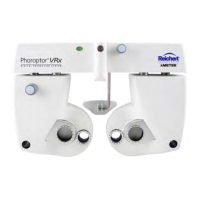Guidance Tables
Table 201 – Guidance and Manufacturer’s Declaration
Electromagnetic Emissions
All Equipment and Systems
Guidance and Manufacturer’s Declaration – Electromagnetic Emissions
The Phoroptor VRx is intended for use in the electromagnetic environment specied
below. The customer or user of the Phoroptor VRx should ensure that it is used in such an
environment.
Emissions Test Compliance
Electromagnetic Environment
- Guidance -
RF Emissions
CISPR 11
Group 1
Class B
The Phoroptor VRx uses RF energy only for its internal
function. Therefore, its RF emissions are very low
and are not likely to cause any interference in nearby
electronic equipment.
Harmonics
IEC 61000-3-2
Class A
The Phoroptor VRx is suitable for use in all
establishments, including domestic establishments
and those directly connected to the public low-voltage
power supply network that supplies building for
domestic power.
Flicker
IEC 61000-3-3
Complies
Guidance Tables
Bluetooth RF Transmitter Characteristics - Central Unit
• Contains FCC ID: QOQWT11I
• Contains IC: 5123A - BGTWT11I
• Frequency 2400.0 - 2483.5 MHz, Spread Spectrum, 0.02 Watts
Bluetooth Adapter (Dongle) Characteristics
• Contains ICC ID: S7AIW02
• Contains IC: 8154A - 1W02
• Frequency 2400.0 - 2483.5 MHz, Spread Spectrum, 0.0264 Watts
FCC / IC Statements
This device complies with Part 15 of the FCC Rules. Operation is subject to the following two conditions:
1. This device may not cause harmful interference, and
2. This device must accept any interference received, including interference that may cause
undesired operation.
This equipment complies with FCC radiation exposure limits set forth for an uncontrolled environment.
End users must follow the specific operating instructions for satisfying RF exposure compliance. This
transmitter must not be co-located or operating in conjunction with any other antenna or transmitter,
except in accordance with FCC test procedures. This transmitter is considered as mobile device.
This device complies with Industry Canada licence-exempt RSS standard(s). Operation is subject
to the following two conditions: (1) this device may not cause interference, and (2) this device must
accept any interference, including interference that may cause undesired operation of the device.
106 16241-101 Rev. D

